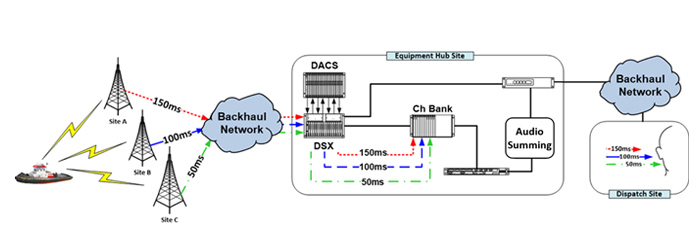Echo Mitigation System for the U.S. Coast Guard

Description:
GL Communications Inc. partnered with Motorola to develop and deploy an Echo Mitigation System for the U.S. Coast Guard in Alaska during 2016-2017. The U.S. Coast Guard faced a challenging engineering problem wherein echo was heard in radio communications between dispatchers at central sites and distressed mariners at sea. The echo made the audio difficult to understand and sometimes totally unintelligible.
One of the major missions of the US Coast Guard is to ensure maritime safety over the vast coastline of the US. In sparsely inhabited and wide geographic spaces like the Alaska coastline, multiple antenna sites are used to cover the broad area reliably. In this architecture, multiple antenna sites pick up the same radio signal from mariners and transmit the signals to the central dispatcher location with different delays due to the diverse paths taken in the backhaul. When the signals are summed and played to the dispatcher, reverberations or echo are heard. The different backhaul networks included microwave, terrestrial fiber, and satellite links – all of which introduce different delays. Typically the terrestrial fiber is the quickest transmission path and the satellite links are the slowest. This results in unsynchronized audio streams arriving at dispatch. This echo effect results in degraded audio quality. This problem also occurs for outbound communications to the mariners when the dispatch operators transmit on multiple radios. The degraded audio quality can result in life threatening situations for vessels in distress at sea.
At the equipment hub site, the audio streams were converted to DS0s and transmitted on T1 networks to the dispatch site.
GL Communications provided custom built hardware and expertise in solving this challenging problem. The hardware, known as the ‘Octal T1 Card’, consists of 8 T1 ports which can monitor 4 full duplex T1 lines. The Octal T1 Card can also add delay to individual DS0s. The Octal T1 Cards were placed in server rack PCs to minimize space requirements. A keyboard, video, mouse (KVM) system was also provided to conveniently configure all of the Octal T1 Cards. Adding carefully calculated delay to the different audio streams ensures that the audio streams arrive in phase at the dispatch site (no echo). GL Communications carefully computed the required delay to add depending on which backhaul network was used to transport the audio. This resulted in much clearer audio and better communications for both the dispatch operators and the mariners at sea.
During this project, GL Communications flew out to multiple sites in Alaska and performed the equipment installation, computed the required delay values, configured the Echo Mitigation System, verified the resulting audio and provided post project support. GL Communications also provided comprehensive documentation including test plans, network diagrams, configuration files, user manuals and test results. GL also ensured operational performance metrics including Mean Time Between Failure, Mean Time To Restore and Availability satisfied U.S. Coast Guard requirements.
GL Communications provided outstanding engineering services to both Motorola and the U.S. Coast Guard on mission critical networks.